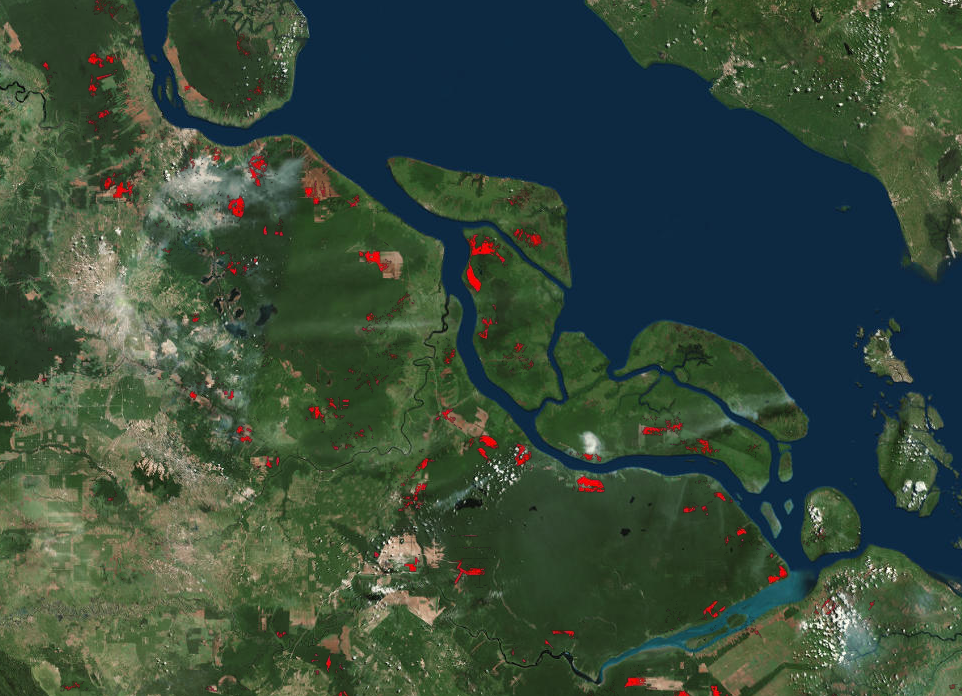Forest fires displacing wildlife, endangering human lives across Southeast Asia
Every year, thousands of hectares of Indonesian forest are illegally burned by development companies. However, Indonesia’s Minister of Environment, Balthasar Kambuaya, is optimistic that legal charges over such fires can be completed – even though he has just three months left in office.
“I hope [the environment ministry] can complete the tasks [to get the cases to trial]. Although, it also depends on the prosecutors [to try the cases]. We will coordinate with the prosecutors to push the cases [in] these last months,” said Kambuaya, who has promised to wrap up the cases before October when his term as minister ends.

An oil palm plantation that was burned to the ground during recent fires in Riau, Sumatra. Photo by Rhett A. Butler.
Indonesia’s government has sped up investigations into forest fires allegedly set by oil palm companies in Riau. There has also been an overall increase in investigations by the ministry.
In 2012, two companies, PT Kallista Alam and Surya Panen Subur, were investigated. PT Kallista Alam was found guilty of illegal burning by the Meulaboh District Court in Aceh province and was required to pay $31 million (Rp362 billion) for environmental destruction fines and damage recovery costs. Kallista Alam’s field manager, Khamidin Yoesoef, was found guilty and sentenced to three years in prison and ordered to pay a fine of $257,000 (Rp3 billion). Its director, Subianto, was also fined $257,000 but received no prison sentence.
Meanwhile, Surya Panen Subur was tried at the Meulaboh District Court for criminal charges and South Jakarta District Court for civil charges. As of August 2014, both charges are awaiting judicial decision.
In 2013, the ministry of environment filed criminal charges and one civil lawsuit against seven companies – three oil palm plantations and four industrial forest plantations. Currently, the criminal charges are being processed by prosecutors, while the civil lawsuit is being drafted.

Riau fire activity between Aug. 6 and 13, 2014. Map courtesy of Global Forest Watch. Click to enlarge.

West Kalimantan fire activity between Aug. 6 and 13, 2014. Map courtesy of Global Forest Watch. Click to enlarge.
In 2014, the ministry of environment launched aggressive investigations into 29 forest fire cases in Riau province involving a total of 26 companies. However, five cases were subsequently excluded. Currently, official investigations are focused on three companies.
“[The environment ministry lacks] investigators and experts to help with the investigations, but we need to work to achieve the target. We will optimize our civil investigators and do our best [in] these last months. If we can’t achieve them, then we will just say what are the challenges are,” said Imam Hendargo, Executing Director for Legal Compliance at the ministry.
Furthermore, Hendargo said the higher number of companies being investigated this year is a result of better coordination between law enforcement and local government.
“We are getting better in setting up the charges and we got help from other institutions, such as UKP4 (President’s Delivery Unit for Development Monitoring and Oversight),” he said. “We also have better coordination and cooperation with judges, police, and prosecutors on forest fire investigations.”
Henry Bastaman, Deputy Minister for Environment Technical Facility and Capacity Building, admitted there is still a lack of ministry investigators, but confidence and capacity have increased in regard to illegal burning cases due to cooperation between the ministry and law enforcement.
“With increasing numbers of companies we investigated, I can fairly say that this is a warning for them that the ministry is strong enough now to make the charges. We have [had] better networks, facilities and resources for the past two [to] three years,” Bastaman said.

Concessions with the highest number of fire alerts between Aug. 6 and 13, 2014. Courtesy of World Resources Institute.
Fire activity was particularly strong during Indonesia’s dry season between June and August 2014, according to Arief Yuwono, deputy minister for environment damage control and climate change.
“By July, there [were] increased hotspots in all provinces prone to forest fires, especially in West Kalimantan,” Yuwono said. “The second dry season is predicted [to last] until October, and at least 10,000 hectares [have been burned down] so far. We also have to add North Kalimantan into the list of provinces prone to forest fires.”
Forest fires are contributing to forest loss in a country already ravaged by deforestation. According to data from Global Forest Watch, Indonesia lost nearly 16 million hectares of forest between 2001 and 2013 alone. Of that, half occurred in Sumatra. Palm oil and pulp companies are responsible for much of the country’s forest loss, and often burn forest to clear land for plantation development. Further compounding the problem, cleared and drained land itself becomes more vulnerable to fire as it dries out normally wet, fire-resistant tropical forest.
In total, there are nine provinces considered prone to forest fires – four in Sumatra (Riau, Jambi, South Sumatra, and North Sumatra) and five in Kalimantan (West Kalimantan, South Kalimantan, Central Kalimantan, East Kalimantan, and North Kalimantan).

Land-use breakdown of fire alert activity between Aug. 6 and 13, 2014. Courtesy of World Resources Institute.

Concessions with the highest number of fire alerts between Aug. 6 and 13, 2014. Courtesy of World Resources Institute.
“There have been efforts from the government to put out fires, especially in establishing the Fire Care Community (Masyarakat Peduli Api) where local people take initiatives to put out these fires before getting too big,” said Yuwono.
Yuwono underlined the severity of the fires, both in terms of ecological and human health. He said they lead to great losses of biodiversity and can cause medical issues in people living near areas being burned. These effects extend past the burn areas; a report by Greenpeace issued earlier this year found that, globally, smoke from Indonesian forest fires contributes to the deaths of 110,000 people annually. The number climbs to 300,000 during El Nino events – one of which is expected by climate scientists to occur later this year.
Yuowono stressed the importance of tackling forest fires by getting to the root of the problem.
“These fires are not just about burning trees or dry season,” he said. “Yes, they do take part [in] why fires happen. But, we also need to settle the problems from the core, which is overlapping permits and spatial planning. We need to figure out who’s exactly making this mess.”

Active fires between Aug. 6 and 13, 2014, detected via data from NASA. Darker dots indicated higher confidence fires. Courtesy of Global Forest Watch. Click to enlarge.

Wind direction, which transports smoke from Indonesian fires (orange and yellow dots) across Southeast Asia. Courtesy of Global Forest Watch. Click to enlarge.

Burn scars in northeastern Riau as mapped by Google Earth Engine. Courtesy of Global Forest Watch. Click to enlarge.
}}
Related articles
Singapore to fine domestic, foreign companies for causing haze
(08/07/2014) Singapore’s parliament has approved a controversial measure that could penalize companies — both foreign and domestic — that are responsible for causing haze overseas, reports Reuters.
NASA: Sumatra fires in the rise
(07/22/2014) The number of fires burning in Sumatra’s Riau Province doubled on Sunday, raising concerns that dry conditions could unleash an especially severe haze this dry season in Indonesia.
Do Indonesians really want more big plantations?
(07/04/2014) How to best use Indonesia’s land resources? This is one of the more crucial questions facing the Presidential candidates in Indonesia’s upcoming elections.
Indonesian presidential candidates ignore environmental concerns as haze returns
(06/24/2014) New data from NASA and the World Resources Institute (WRI) show that peat fires are again burning in Sumatra, yet both leading presidential contenders are ignoring the issue of climate change, says a top official.
Another year of fires, another year of inaction
(06/06/2014) With a 70% chance of an El Niño this year, Indonesia could soon be facing the ire of its nearest neighbors yet again as the dry season approaches with the ever present threat of vegetation fires.

(06/05/2014) In 1997, Gabriella Fredriksson, then a young PhD student, was studying sun bears in East Kalamantan, Indonesia, when massive forest fires broke out in the park. ‘It quickly became clear that there was no government agency, NGO, or private company in the area interested in assisting putting out these fires, which were threatening to burn down the entire reserve,’ Fredriksson told mongabay.com.
Logging, fires take a hidden toll on Amazon rainforest

(05/28/2014) Selective logging and small sub-canopy fires are degrading vast areas of rainforest across the Brazilian Amazon, contributing to largely hidden carbon emissions, argues a study published today in Global Change Biology. The research found stark differences in carbon storage between primary forests, selectively logged forests, logged and burned forests, and regrowing or secondary forests.
Indonesia’s haze from forest fires kills 110,000 people per year

(05/28/2014) Haze caused by burning peat forests in Indonesia kills an average of 110,000 people per year and up to 300,000 during el Niño events, while releasing hundreds of millions of tons of greenhouse gases into the atmosphere, warns a new report from Greenpeace. Sumatra: Going up in smoke argues that peatland and forest protection are the best way to protect the region from the effects of haze.
NASA data: 1997 all over again for Indonesia?

(05/14/2014) The latest data from NASA shows that conditions developing in the tropical Pacific are eerily similar to those in 1997, when El Niño wreaked havoc across Indonesia, spurring a severe drought that exacerbated massive peatland and forest fires which spread choking haze across much of South and Southeast Asia.